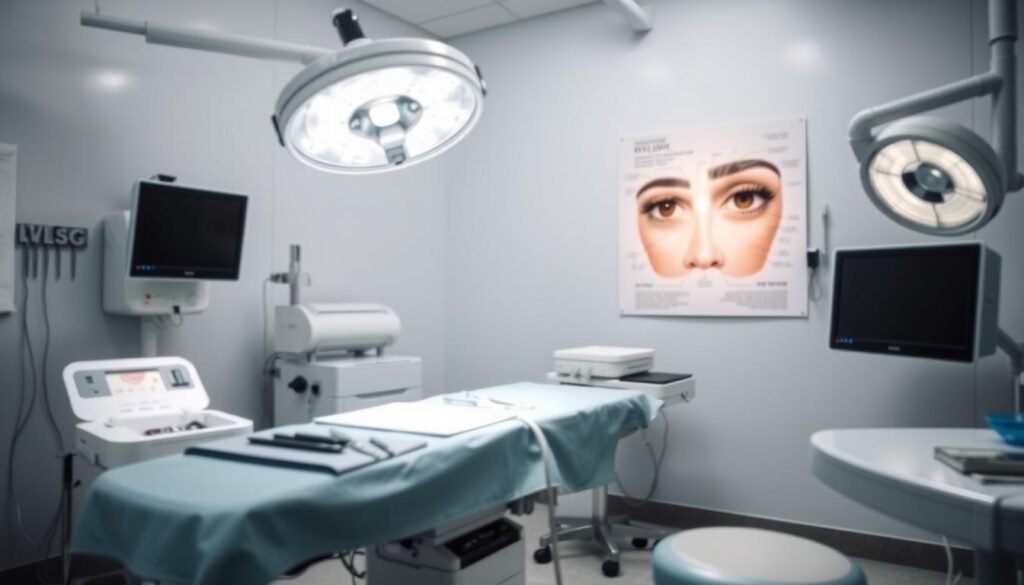Are you thinking about eyelid surgery but wonder if your insurance will help pay? Eyelid surgery, also known as blepharoplasty or ptosis repair, can make your vision better and improve your life. But you might ask, when will insurance pay for eyelid surgery?
Choosing to have eyelid surgery is a big decision. If your eyelids are droopy, it can make seeing and doing everyday things hard. Many worry about if insurance will pay for it. Some surgeries can help your vision and are called Functional Eyelid Surgery. This includes things like an upper eyelid lift or fixing eyelid ptosis. But, if you want surgery just to look better, it’s not usually covered by insurance.
Key Takeaways
- Insurance might pay for eyelid surgery if it’s needed to fix vision problems from too much skin.
- Functional eyelid surgery can fix things like too much skin, lift the eyelash line, or fix a droopy brow.
- Insurance companies often need a visual field test to see if you qualify for coverage.
- Coverage can differ, with some plans paying all or part of the surgery cost.
- Oculoplastic surgeons are experts who can do these surgeries.
What is Eyelid Surgery?
Blepharoplasty, or eyelid surgery, is a way to fix extra skin and fat in the eyelids. It’s done for both functional and cosmetic reasons.
Functional vs. Cosmetic Eyelid Surgery
Functional surgery helps your eyes work better. It fixes drooping eyelids or excess eyelid skin that gets in the way of seeing. Cosmetic surgery makes your eyes look better but doesn’t fix any health issues.
Insurance might pay for blepharoplasty or ptosis repair if it’s needed for health reasons. They look for things like doctor’s notes and tests showing your vision got better.
Insurance might also cover surgery for thyroid eye disease, congenital ptosis, or chronic dermatitis. But, cosmetic eyelid surgery is usually not covered.
“Eyelid surgery is considered one of the most popular procedures among mature patients seeking facial enhancement.”

When Does Insurance Cover Eyelid Surgery?
Insurance might cover eyelid surgery if it’s needed for a medical reason. This surgery is called blepharoplasty. It helps with vision problems caused by too much skin on the eyelids. This makes things like driving, reading, and using tech hard.
Conditions like ptosis (eyelids that droop), dermatochalasis (too much eyelid skin), and visual field obstruction might get insurance coverage. This is if they really affect how you see and do daily tasks. Insurance wants to see proof like tests, pictures, and your health history to decide.
Doctors also check for other issues before saying yes to insurance. These include Keratitis, Ptosis, Malar festoons, Protrusion of orbital fat, Blepharochalasis, and Hypertrophy of the orbicularis oculi. Getting insurance to say yes can take a long time. It depends on your health, family health, past surgeries, and overall wellness.
| Condition | Insurance Coverage |
|---|---|
| Ptosis (Drooping Eyelids) | Typically covered if it significantly impairs vision |
| Dermatochalasis (Excess Eyelid Skin) | Often covered if it obstructs visual field |
| Visual Field Obstruction | Eligible for coverage when it impairs daily activities |
Before surgery, you need to talk to a doctor about insurance. They will check if you need the surgery and what you need to do next. Be ready to give lots of information to show why you need the surgery.
How to get insurance to pay for eyelid surgery
The Pre-Approval Process
If you’re thinking about eyelid surgery, first check if your insurance will cover it. Getting insurance to pay for eyelid surgery means going through a pre-approval process. It’s key to know what insurance looks for to cover this surgery.
To get insurance to cover eyelid surgery, you must show it’s needed for health reasons, not just looks. Insurance looks at Medicare guidelines for things like blepharoplasty (eyelid lift) or ptosis repair (fixing droopy eyelids).
First, see an eye doctor who can write a letter saying your eyelid issue is blocking your view. They might do a test to see how much it’s affecting you.
- Your doctor must send photos showing too much eyelid skin near your pupil.
- Insurance wants detailed notes from your doctor about the lid’s position, vision problems, and how it affects your daily life.
- After getting this medical proof, the insurer will check if the surgery is covered.
Pre-approval doesn’t mean you’re sure to get full coverage. But it shows the insurer thinks the surgery is needed for health reasons. Remember, each insurance plan and provider has its own rules.

Understanding the pre-approval process and getting the right documents can help you get insurance for eyelid surgery. Working with your healthcare team can make things easier and help you get the results you want.
Surgeon Credentials and Expertise
Choosing the right doctor for eyelid surgery is very important. Oculoplastic surgeons are top experts. They get extra training for 2 years in the American Society of Ophthalmic Plastic and Reconstructive Surgery.
These surgeons know a lot about the eyes and eyelids. They can make sure your surgery works well and looks good. Their special training and focus on this area make them the best choice for great results.
When picking an eyelid surgery surgeon, check if they are board certified. They should be certified by the American Board of Plastic Surgery or the American Board of Ophthalmology. This means they follow the highest safety and quality standards.
“Choosing an oculoplastic surgeon who is a member of the American Society of Ophthalmic Plastic and Reconstructive Surgery is the best way to ensure you receive the highest level of care and expertise for your eyelid procedure.”
With a skilled eyelid surgery surgeon, you know you’re in good hands. They have the right skills and qualifications. You can trust them to improve your vision and look.

Out-of-Pocket Costs
Even if your eyelid surgery is covered by insurance, you might still pay out-of-pocket. Insurance plans often limit what they cover for eyelid procedures. They might only pay for one type of surgery, like removing extra skin or lifting a droopy eyelid. Medicare and other insurers also have rules on what eyelid surgeries they will pay for.
The average cost of a blepharoplasty (eyelid surgery) is over $3,000. Costs for upper eyelid surgery range from $3,304 to $8,054. Lower eyelid surgery costs range from $3,234 to $8,005. On average, upper eyelid surgery costs $4,313, and lower eyelid surgery costs $4,177 in the U.S.
Things that can change the cost of eyelid surgery include the surgery’s complexity, the doctor’s skills, the type of anesthesia, and where the surgery is done. Insurance usually doesn’t pay for eyelid surgeries for looks. But, it might pay if the surgery is needed for vision problems.
Many clinics offer financing options and payment plans to help with costs. Health care saving accounts can’t be used for cosmetic blepharoplasty. But, you can use specialty credit cards like CareCredit for cosmetic procedures.
| Procedure | Average Cost | Cost Range |
|---|---|---|
| Upper Eyelid Surgery | $4,313 | $3,304 – $8,054 |
| Lower Eyelid Surgery | $4,177 | $3,234 – $8,005 |
It’s key to know your insurance plan well to avoid surprise costs. This way, you can make sure your eyelid surgery is fully covered.
Appealing a Denial
If your insurance says no to eyelid surgery, don’t give up. You can appeal the decision. To win your appeal, you’ll need more proof from your doctor.
Your doctor should give detailed notes on how your eyelids affect your vision and daily life. This shows why you need the surgery. You also need to explain how the surgery will help you see better and improve your life.
Working with your surgeon and insurance company is key during the appeal. They can tell you what proof you need. With the right evidence and effort, you might get your insurance denial for eyelid surgery changed.
- Get detailed medical proof from your surgeon
- Advocate for the medical need of the surgery
- Work with your insurance during the appeal
Remember, the main thing is to give more proof and explain why you need the surgery. By doing the right steps, you can appeal an insurance denial for eyelid surgery successfully.
“Persistence and a well-crafted appeal can make all the difference in getting your eyelid surgery covered by insurance.”
Conclusion
Getting insurance to cover eyelid surgery can be hard, but it’s doable if it’s needed for your health. Work closely with your doctor to show how your eyelid issue affects your vision. This will help you prove it to your insurance company.
Know what your insurance needs for coverage and go through the pre-approval steps. This can help you get your eyelid surgery covered by your insurance. Being persistent and careful is key to getting insurance to pay. If your claim gets denied, you might need to appeal or get legal help.
Here are the main points for getting insurance to pay for eyelid surgery. Make sure you have all your medical records ready. Work with a skilled surgeon. And be ready for the complex insurance claims process. With these steps, you can get past the challenges and enjoy the benefits of eyelid surgery without spending too much money.
FAQ
What is the difference between functional and cosmetic eyelid surgery?
Functional eyelid surgery helps with vision by fixing issues like droopy eyelids. Cosmetic surgery makes the eyes look better but doesn’t fix vision problems.
When will insurance cover eyelid surgery?
Insurance covers eyelid surgery if it’s needed for medical reasons. This includes fixing vision issues from too much eyelid skin. Conditions like droopy eyelids or too much skin can be covered if they affect your vision and daily life.
What is the pre-approval process for getting insurance to pay for eyelid surgery?
First, check with your insurance to see if eyelid surgery is covered. If it is, see an optometrist for an exam. They’ll write a note saying you need the surgery.
Then, the doctor will send in photos and test results for approval. Insurance needs proof that the surgery will help your vision a lot.
Why is it important to choose an experienced surgical specialist for eyelid surgery?
Choosing a skilled surgeon is key for your eyes. Oculoplastic surgeons are experts in eye and eyelid surgery. They know how to make sure you get the best results.
What are the potential out-of-pocket costs for eyelid surgery even if it is deemed medically necessary?
Even if insurance covers part of the surgery, you might still pay out-of-pocket. Some plans only cover certain types of procedures. Medicare and other insurers have rules too. Knowing your insurance plan can help avoid surprise costs.
What can I do if my insurance provider denies coverage for eyelid surgery?
If insurance says no, you can appeal. Your doctor can give more info on how the surgery will help you. Showing how it will improve your life and vision might help. Working with your surgeon and insurance can increase your chances of getting coverage.
